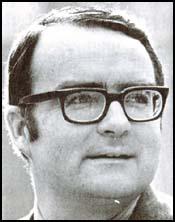William Ruckelshaus

William Doyle Ruckelshaus was born in Indianapolis on 24th July, 1932. After graduating from Princeton University and Harvard Law School he became a lawyer.
In 1960 Ruckelshaus was appointed Deputy Attorney General of Indiana. A member of the Republican Party he was elected to the Indiana House of Representatives. He was an unsuccessful candidate for the United States Senate in 1968.
In 1969 President Richard Nixon appointed Ruckelshaus as Assistant Attorney General in charge of the Civil Division for the U.S. Department of Justice. The following year he became head of the United States Environmental Protection Agency.
J. Edgar Hoover, the Director of the FBI, died on 2nd May, 1972. Rather than appoint an insider such as Mark Felt, Nixon gave the job to L. Patrick Gray. A month after taking office the Watergate break-in took place. Soon afterwards Nixon ordered Gray to interfere in the FBI investigation of the burglary.
During congressional confirmation hearings in March 1973, L. Patrick Gray admitted that he had passed files from the FBI's Watergate investigation to White House counsel John Dean. Gray was forced to resign on 27th April, 1973, after the disclosure that he destroyed papers from the White House safe of E. Howard Hunt, the former CIA agent who had organized the Watergate break-in. However he was never indicted for any Watergate-related crimes.
Richard Nixon now appointed Ruckelshaus as acting Director of the FBI. Later that year he became Deputy Attorney General of the United States Department of Justice.
On 18th May, 1973, Attorney General Elliot Richardson appointed Archibald Cox as special prosecutor, with unprecedented authority and independence to investigate the alleged Watergate cover-up and illegal activity in the 1972 presidential campaign.
The following month John Dean testified that at a meeting with Richard Nixon on 15th April, the president had remarked that he had probably been foolish to have discussed his attempts to get clemency for E. Howard Hunt with Charles Colson. Dean concluded from this that Nixon's office might be bugged. On Friday, 13th July, Alexander P. Butterfield appeared before the committee and was asked about if he knew whether Nixon was recording meetings he was having in the White House. Butterfield reluctantly admitted details of the tape system which monitored Nixon's conversations.
Alexander P. Butterfield also said that he knew "it was probably the one thing that the President would not want revealed". This information did indeed interest Archibald Cox and he demanded that Richard Nixon hand over the White House tapes. Nixon refused and so Cox appealed to the Supreme Court.
On 20th October, 1973, Nixon ordered his Attorney-General, Elliot Richardson, to fire Archibald Cox. Richardson refused and resigned in protest. Nixon then ordered the deputy Attorney-General, William Ruckelshaus, to fire Cox. Ruckelshaus also refused and he was sacked. Eventually, Robert Bork, the Solicitor-General, fired Cox.
An estimated 450,000 telegrams went sent to Richard Nixon protesting against his decision to remove Cox. The heads of 17 law colleges now called for Nixon's impeachment. Nixon was unable to resist the pressure and on 23rd October he agreed to comply with the subpoena and began releasing some of the tapes. The following month a gap of over 18 minutes was discovered on the tape of the conversation between Nixon and H. R. Haldemanon June 20, 1972. Nixon's secretary, Rose Mary Woods, denied deliberately erasing the tape. It was now clear that Nixon had been involved in the cover-up and members of the Senate began to call for his impeachment.
Peter Rodino, who was chairman of the Judiciary Committee, presided over the impeachment proceedings against Nixon. The hearings opened in May 1974. The committee had to vote on five articles of impeachment and it was thought that members would split on party lines. However, on the three main charges - obstructing justice, abuse of power and withholding evidence, the majority of Republicans voted with the Democrats.
Two weeks later three senior Republican congressmen, Barry Goldwater, Hugh Scott, John Rhodes visited Richard Nixon to tell him that they were going to vote for his impeachment. Nixon, convinced that he will lose the vote, decided to resign as president of the United States.
After leaving the Justice Department, Ruckelshaus returned to the private sector and eventually became Senior Vice-President of Legal Affairs of Weyerhaeuser.
In 1983 President Ronald Reagan appointed Ruckelshaus to serve as interim director of the EPM, a position he held through most of the following year. He joined Perkins Coie in 1985, a Seattle based law firm.
